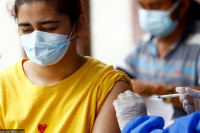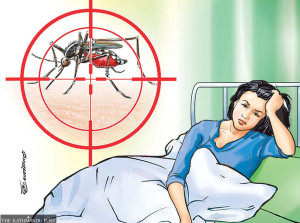Health
JE death toll rises to nine as disease spreads
Infections have risen from 13 to 54 in two weeks. Unvaccinated adults at high risk.
Post Report
At least nine people died, and 54 others have been infected with the Japanese encephalitis (JE), which has spread in 50 local levels of 24 districts across the country. All seven provinces across the country have reported the outbreak of the deadly disease.
The number of infections and deaths from JE virus has been rising alarmingly. Just two weeks ago, only 13 infections and two deaths were reported.
According to data provided by the Ministry of Health and Population, 36 males and 27 females have been infected so far. Of the total nine deaths, five were female and four male. Koshi and Bagmati provinces reported three deaths each, Lumbini province reported two, and Madhesh reported one death.
JE is a viral brain infection endemic to Asia and parts of the Western Pacific. According to the World Health Organisation, it is a mosquito-borne flavivirus belonging to the same family as dengue, Zika, yellow fever, and West Nile viruses. The virus kills a third of those who fall ill and leaves up to half of the survivors with severe lifelong disabilities, according to the UN health body.
Last year, 23 people succumbed to the disease, including one in the Kathmandu Valley, and over 80 people were infected. Doctors say the actual number of cases could be higher, as tests were carried out only on hospitalised patients with severe symptoms.
This year, JE cases have been reported in Morang, Bara, Jhapa, Saptari, Siraha, Sarlahi, Parsa, Nawalparasi West, Nawalparasi East, Sindhuli, Bardia, Kailali, and Chitwan districts. Likewise, Dang, Pyuthan, Gulmi, Kapilvastu, Rautahat, Dhanusha, Terhathum, and Ilam have also reported JE infection.
Also, the farwestern mountain district of Jumla also reported JE cases in Sinja.
With rising infections, the case fatality rate has also increased to over 14 percent, which indicates that the country is again witnessing a resurgence of the deadly disease, which has killed and infected thousands of people in the past. Most of those infected and dead were unvaccinated.
Experts warn that without vaccination, these vulnerable populations are at high risk, but the government has yet to take decisive action to contain the outbreak.
Data show mortality is higher among those above 15 years of age, which indicates that unvaccinated adults are at higher risk.
Health authorities admit that they do not have immediate plans for vaccination.
“We have not held any meeting regarding JE vaccination for adults,” said Dr Ramesh Kanta Adhikari, chief of the National Immunisation Advisory Committee. “Vaccination is not a solution for controlling the current outbreak, but it provides protection against future infections.”
JE vaccine is provided to all children under the routine immunisation programme, according to Adhikari.
Health Ministry officials say they lack a budget to launch a vaccination drive for the adult population.
Authorities have focussed on preventive measures, including awareness drives, environment management for vector control, and case management training for doctors in disease-hit districts.
However, the rise in the number of infections in Tarai districts shows that those measures are not sufficient.
Health Ministry officials admit that JE is the number one killer among vector-borne diseases in Nepal and say they attempted to convince development partners, including the World Health Organisation, to support a mass JE vaccination campaign over the past year, without success.
In 2005, JE killed nearly 2,000 people in Nepal—mostly children from Tarai districts. Nepal started administering the JE vaccine in 2006, eight years before the World Health Organisation officially issued prequalification certification, due to the high rates of infection and deaths from the virus at the time.
In the first phase, all populations of the highly affected four districts—Banke, Bardiya, Dang, and Kailali—reveived the JE vaccine. Later, the vaccination programme was expanded to 19 other affected districts, and children under 15 were inoculated.
The government integrated the JE vaccine into routine immunisation in 2015. Still, people continue to die and dozens get infected by the deadly virus every year.
Public health experts say this is the right time to vaccinate all those at risk. Even if the vaccine does not help in outbreak management, it provides immunity against future infections, according to them.
The JE virus is transmitted to humans through the bite of infected Culex mosquitoes. Pigs and ducks are considered natural reservoirs of the virus. Complications from JE infection can cause permanent injuries to the brain and the nervous system. The disease has no cure, so treatment focuses on managing symptoms. However, safe and effective vaccines have been developed to prevent infection.
Doctors advise avoiding mosquito bites, such as by using mosquito repellents, wearing long-sleeved clothes, and getting vaccinated if one lives in or travels to disease-endemic areas. They also stress the importance of awareness and timely treatment to prevent infections and deaths.
An estimated 12.5 million people are thought to be at high risk of JE infection in Nepal.




 12.12°C Kathmandu
12.12°C Kathmandu













